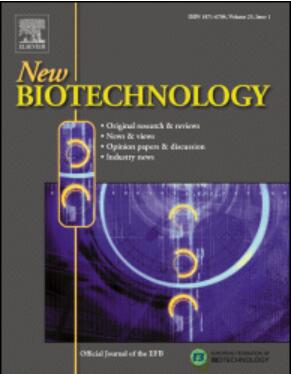Valorization of prosecco wine lees for sustainable polyhydroxyalkanoates production by Cupriavidus necator DSM 545 and Hydrogenophaga pseudoflava DSM 1034
IF 4.9
2区 生物学
Q1 BIOCHEMICAL RESEARCH METHODS
引用次数: 0
Abstract
Nowadays, in the agricultural and agro-industrial sectors, there is increasing attention on the wine industry. The environmental impact of wine production, particularly in terms of residues generation, is a growing concern. Among generated residues, wine lees, rich in organic matter, phenols compounds, and with low pH, pose environmental challenges due to their disposal requirements. Despite their usage for biogas production and extraction of compounds, such as antioxidants, tartaric acid and ethanol, their potential in bioplastic production, specifically polyhydroxyalkanoates (PHAs), remains largely untapped. This study aims to evaluate the potential use of wine lees as a medium sustaining bacterial growth and PHAs accumulation. Specifically, Cupriavidus necator DSM 545 and Hydrogenophaga pseudoflava DSM 1034, were cultivated in the liquid phase of wine lees obtained from the Prosecco winemaking. On pure distilled wine lees, after mild feedstock pre-treatments, C. necator DSM 545 reached a CDW (cell dry weight) of 2.97 g/L and accumulated PHAs was 1.27 g/L, pair to 42.90 % of CDW. On the same substrate, CDW for H. pseudoflava DSM 1034 was 3.96 g/L and PHAs reached values of 1.60 g/L and 40.42 % CDW. These results obtained on wine lees are similar or even better than those achieved in the control growths of the two strains on pure glucose.
This is the first approach for the utilization of wine lees for PHAs production, highlighting their potential use in the PHAs industry, and offering a sustainable alternative for both residues management and bioplastic production.
用Cupriavidus necator DSM 545和Hydrogenophaga pseudoflava DSM 1034可持续生产聚羟基烷烃酸酯的普罗赛克酒糟的价值评价
如今,在农业和农用工业部门,人们越来越关注葡萄酒行业。葡萄酒生产对环境的影响,特别是在产生残留物方面,是一个日益关注的问题。在产生的残留物中,酒渣富含有机物和酚类化合物,且pH值较低,由于其处理要求,对环境构成了挑战。尽管它们用于生产沼气和提取抗氧化剂、酒石酸和乙醇等化合物,但它们在生物塑料生产方面的潜力,特别是聚羟基烷酸酯(PHAs),在很大程度上仍未得到开发。本研究旨在评估酒渣作为维持细菌生长和pha积累的培养基的潜在用途。具体而言,在普罗赛克葡萄酒酿造过程中获得的酒糟的液相中培养Cupriavidus necator DSM 545和Hydrogenophaga pseudoflava DSM 1034。在纯蒸馏酒糟上,经过温和的原料预处理,C. necator DSM 545的细胞干重为2.97 g/L,累积pha为1.27 g/L,占CDW的42.90 %。在相同的底物上,H. pseudoflava DSM 1034的CDW为3.96 g/L, pha达到1.60 g/L和40.42 % CDW。在酒渣上获得的这些结果与两种菌株在纯葡萄糖上的对照生长所获得的结果相似甚至更好。这是第一个利用酒渣生产pha的方法,突出了它们在pha工业中的潜在用途,并为残留物管理和生物塑料生产提供了可持续的替代方案。
本文章由计算机程序翻译,如有差异,请以英文原文为准。
求助全文
约1分钟内获得全文
求助全文
来源期刊

New biotechnology
生物-生化研究方法
CiteScore
11.40
自引率
1.90%
发文量
77
审稿时长
1 months
期刊介绍:
New Biotechnology is the official journal of the European Federation of Biotechnology (EFB) and is published bimonthly. It covers both the science of biotechnology and its surrounding political, business and financial milieu. The journal publishes peer-reviewed basic research papers, authoritative reviews, feature articles and opinions in all areas of biotechnology. It reflects the full diversity of current biotechnology science, particularly those advances in research and practice that open opportunities for exploitation of knowledge, commercially or otherwise, together with news, discussion and comment on broader issues of general interest and concern. The outlook is fully international.
The scope of the journal includes the research, industrial and commercial aspects of biotechnology, in areas such as: Healthcare and Pharmaceuticals; Food and Agriculture; Biofuels; Genetic Engineering and Molecular Biology; Genomics and Synthetic Biology; Nanotechnology; Environment and Biodiversity; Biocatalysis; Bioremediation; Process engineering.
 求助内容:
求助内容: 应助结果提醒方式:
应助结果提醒方式:


